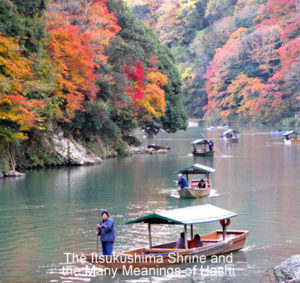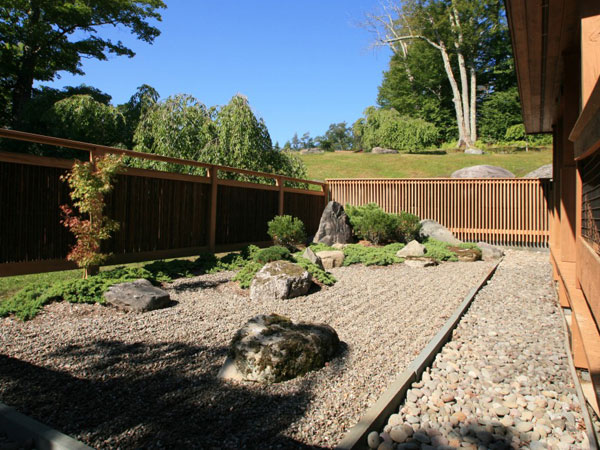Blog

Noguchi’s Body-Space Devices & Our Environment in this Crisis
If you are forced to stay at home in this COVID-19 crisis, the architecture of your home might seem like the enclosure that stops you from moving. The “Body-Space Devices” exhibition at the Noguchi Museum is a good reminder that it should not be. The exhibition (May 2019- May 2020)

The Itsukushima Shrine and the Many Meanings of Hashi
Hashi in motion A secondary concept of Ma is hashi. Generally, hashi means “edge.” The origin of this pronunciation of hashi comes from the Japanese word hashike, meaning a boat, or a barge. Therefore, saying the word hashi unconsciously carries an image of a boat moving between two borders. In this example,

Michiyuki and the Katsura Imperial Villa
Michiyuki: Traveling and Beyond Being under water blurs the self/space boundary because you are always in motion. Michiyuki, the Japanese spatial concept for “moving self,” means traveling from once place to another. It specifically refers to the space you covered and the time you spent while traveling. But by translating

Mindfulness through Ma
More than a gate Another Japanese spatial concept that contributes to designing a mindful space is the boundary in motion. One of the Japanese words for this is Ma, which generally means “gap.” The Chinese character for Ma (間) represents a gate made out of two doors with the moonlight coming through.

Utsuroi in Japanese Architecture and Landscape
Utsuroi: changing space Utsuroi, another Japanese spatial concept that causes the self/space boundary to blur, is present throughout Japanese architecture and gardens. Utsuroi means gradual and inevitable change from one state to another. It can also refer to reflection or projection of one thing onto another. Both meanings suggest that nothing
Categories
- Architecture (24)
- Blog (61)
- Japanese Architecture (13)
- Japanese Garden (25)
- Landscape Architecture (27)
- Space for Well-being (20)
- Talk (10)
- Urbanism (4)
- Workplace (4)
Archives
- April 2024 (1)
- March 2024 (1)
- January 2024 (1)
- December 2023 (2)
- August 2023 (1)
- July 2023 (1)
- April 2023 (1)
- September 2022 (1)
- June 2022 (1)
- May 2022 (1)
- April 2022 (1)
- March 2022 (2)
- November 2021 (1)
- August 2021 (1)
- May 2021 (1)
- November 2020 (1)
- April 2020 (2)
- March 2020 (1)
- February 2020 (1)
- January 2020 (1)
- December 2019 (5)
- September 2019 (1)
- August 2019 (1)
- June 2019 (1)
- April 2019 (1)
- April 2018 (1)
- February 2018 (1)
- December 2017 (2)
- November 2017 (1)
- August 2017 (2)
- July 2017 (3)
- June 2017 (2)
- March 2017 (1)
- August 2016 (1)
- July 2016 (1)
- June 2016 (3)
- May 2016 (2)
- March 2016 (2)
- February 2016 (1)
- January 2016 (2)
- December 2015 (3)
- November 2015 (3)
- October 2015 (2)
- September 2015 (2)
- August 2015 (1)
Follow us
Contact us
Penguin Environmental Design
56 Lynmoor Place, Hamden, CT 06517
info@pedarch.com
Blog

Noguchi’s Body-Space Devices & Our Environment in this Crisis
If you are forced to stay at home in this COVID-19 crisis, the architecture of your home might seem like the enclosure that stops you from moving. The “Body-Space Devices” exhibition at the Noguchi Museum is a good reminder that it should not be. The exhibition (May 2019- May 2020)

The Itsukushima Shrine and the Many Meanings of Hashi
Hashi in motion A secondary concept of Ma is hashi. Generally, hashi means “edge.” The origin of this pronunciation of hashi comes from the Japanese word hashike, meaning a boat, or a barge. Therefore, saying the word hashi unconsciously carries an image of a boat moving between two borders. In this example,

Michiyuki and the Katsura Imperial Villa
Michiyuki: Traveling and Beyond Being under water blurs the self/space boundary because you are always in motion. Michiyuki, the Japanese spatial concept for “moving self,” means traveling from once place to another. It specifically refers to the space you covered and the time you spent while traveling. But by translating

Mindfulness through Ma
More than a gate Another Japanese spatial concept that contributes to designing a mindful space is the boundary in motion. One of the Japanese words for this is Ma, which generally means “gap.” The Chinese character for Ma (間) represents a gate made out of two doors with the moonlight coming through.

Utsuroi in Japanese Architecture and Landscape
Utsuroi: changing space Utsuroi, another Japanese spatial concept that causes the self/space boundary to blur, is present throughout Japanese architecture and gardens. Utsuroi means gradual and inevitable change from one state to another. It can also refer to reflection or projection of one thing onto another. Both meanings suggest that nothing
Categories
- Architecture (24)
- Blog (61)
- Japanese Architecture (13)
- Japanese Garden (25)
- Landscape Architecture (27)
- Space for Well-being (20)
- Talk (10)
- Urbanism (4)
- Workplace (4)
Archives
- April 2024 (1)
- March 2024 (1)
- January 2024 (1)
- December 2023 (2)
- August 2023 (1)
- July 2023 (1)
- April 2023 (1)
- September 2022 (1)
- June 2022 (1)
- May 2022 (1)
- April 2022 (1)
- March 2022 (2)
- November 2021 (1)
- August 2021 (1)
- May 2021 (1)
- November 2020 (1)
- April 2020 (2)
- March 2020 (1)
- February 2020 (1)
- January 2020 (1)
- December 2019 (5)
- September 2019 (1)
- August 2019 (1)
- June 2019 (1)
- April 2019 (1)
- April 2018 (1)
- February 2018 (1)
- December 2017 (2)
- November 2017 (1)
- August 2017 (2)
- July 2017 (3)
- June 2017 (2)
- March 2017 (1)
- August 2016 (1)
- July 2016 (1)
- June 2016 (3)
- May 2016 (2)
- March 2016 (2)
- February 2016 (1)
- January 2016 (2)
- December 2015 (3)
- November 2015 (3)
- October 2015 (2)
- September 2015 (2)
- August 2015 (1)
Follow us
Contact us
Penguin Environmental Design
56 Lynmoor Place, Hamden, CT 06517
info@pedarch.com


